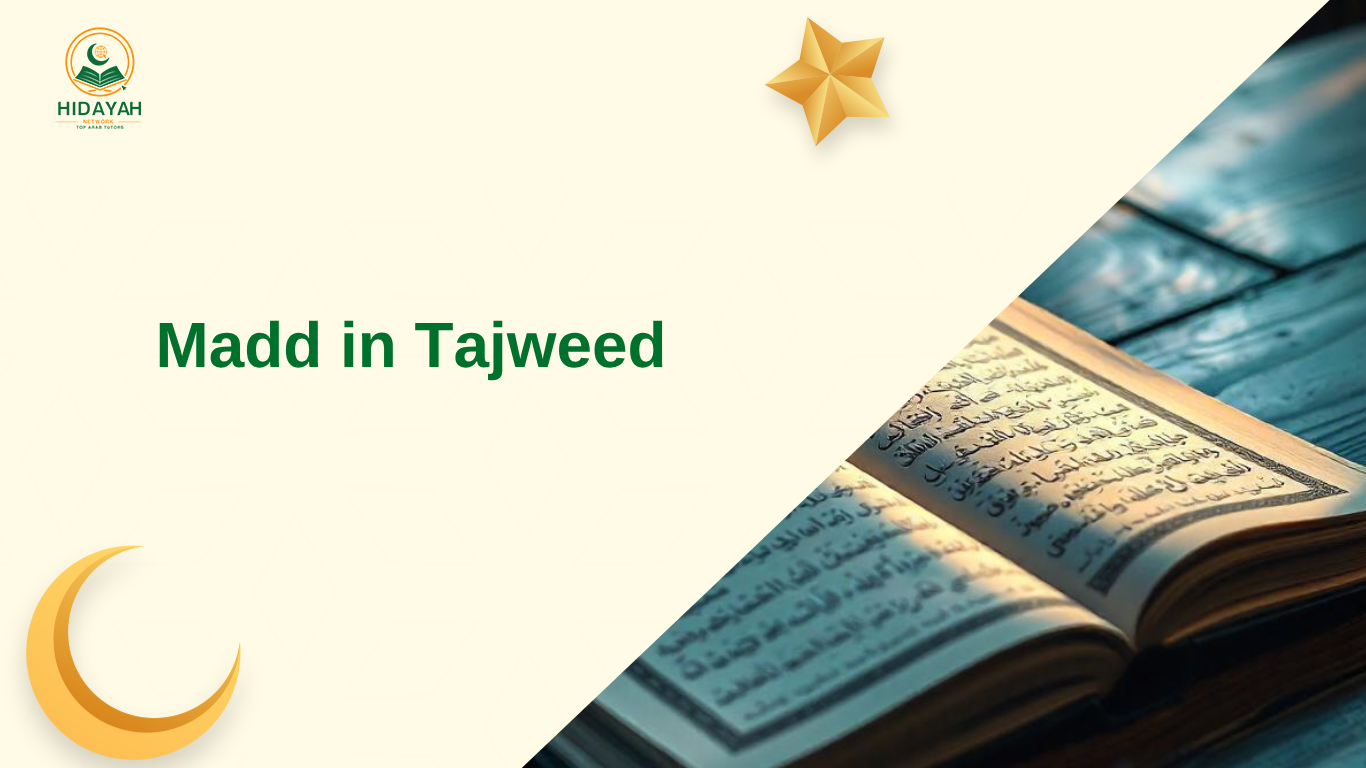In Tajweed, the art of reciting the Quran with correct pronunciation and phonetics, the concept of Madd (pronounced as “lengthening”) plays a significant role. It refers to the elongation of a vowel sound during recitation, affecting the flow and melody of the Quranic verses.
This is an essential feature that distinguishes the correct pronunciation of words from incorrect ones, which is critical in ensuring the preservation and proper understanding of the Quran.
Understanding “Madd” holds pivotal importance. Madd, an Arabic term, refers to the elongation of specific letters in the recitation of the Quran. It is crucial for accurate Quranic recitation.
Essentially, it involves lengthening the sound of letters for a specific duration. In This article delves into the concept of Madd in Tajweed, covering its types, rules, and practical examples for readers to understand its application in Quranic recitation.
What is Madd in Tajweed?
Al-Madd is defined as increasing the sound when pronouncing the Madd letter or the Lin letter with more than two counts when there is a reason to do so like Hamzah or Sukūn. The term Madd comes from the Arabic root word مدّ which means “to extend” or “to lengthen”.
When a letter is extended in Tajweed, it signifies not only a change in sound but also sometimes changes the meaning of a word. Therefore, understanding the rules of Madd is crucial for any student of Tajweed and anyone seeking to recite the Quran with precision and beauty.
What are Madd letters?
There are two groups of letters of Madd:
- First: Ḥūrūf Al-Madd (i.e. Lengthening Letters)
- The constant Alif letter when the precedent letter is Maftūḥ (i.e. Fatḥah is placed on this very precedent letter), such as Qāl, Ḥāl;
- The constant Wāw letter when the precedent letter is Maḍmūm (i.e. Ḍammah is placed on this very precedent letter), such as Yaqūl, Yaḥūl; and
- The constant Yaā’ letter when the precedent letter is Maksūr (i.e. Kasrah is placed on this very precedent letter), such as Qīla, Ḥīla.
- Second: Ḥarfa Al-Līn (i.e. the Two Soft Letters)
- The constant Wāw letter when the precedent letter is Maftūh, such as Yawm, Khawf, the constant Yaā’ letter when the precedent letter is Maftūh, such as Bayt, Quraysh.
- It is thus clear the two constant Yaā’ and Wāw letters can be described as two letters of lengthening or two soft letters; however, in case they are voweled, they would serve as Ḥarfay ‘Illah (i.e. vowels).
Why does Madd occur?
There are two reason why these three letters in particular are the ones to be lengthened is: –
- Suitability of these letters to the prior diacritic mark. For example, the Wāw letter suits the Ḍammah; the Yaā’ letter suits the Kasrah; and the Alif letter suits the Fatḥah.
- Wideness of these letters’ articulation point (i.e. Al-Jawf), since whenever the articulation point is wide, the sound spreads in it. In this regard, we should take into account that the constant Wāw and Yaā’ do not come out from Al-Jawf when the preceding letter is Maftūḥ, because Fatḥa does not suit the Wāw or Yaā’. For this, the constant Wāw comes out of the two lips when the letter before it is Maftūḥ, while the constant Yaā’ comes out from the middle of the tongue along with the u`pper jaw when the letter prior to is Maftūḥ.
- Mark of Madd in the Calligraphy of the Muṣḥaf
- In case this mark “~” is placed above the letter, this indicates that it should be lengthened more than the natural, original Madd.
- Types of Madd in Tajweed With Examples Divisions of Madd: There are two divisions of Madd, namely: Al-Madd Al-Aṣli (i.e. Original Madd) and Al-Madd Al-Far‘i (i.e. Secondary Madd).
Types of Madd in Tajweed With Examples
Divisions of Madd: There are two divisions of Madd, namely: Al-Madd Al-Aṣli (i.e. Original Madd) and Al-Madd Al-Far‘i (i.e. Secondary Madd).
First: Original Madd
- It is called the natural Madd and its lengthening time is two counts on condition that there is no Hamzah before it and no Hamzah or Sukūn after it.
- Reason why it is called “Natural Madd”: –
- It has the same ruling all the time, that is, its lengthening time is two counts.
- The letter itself cannot do without it, and so is the word.
- It is not conditioned on a reason like Hamzah or Sukūn.
Kinds of Natural Madd
- First: Al-Madd Al-Ṭabī‘i Al-Kalemi (i.e. Natural Madd occurring in the word itself), such as Qāla, Yaqūlu, Yuqīmūn, Abṣāruhum, Banāha, Sawwāha, Fīha.
- Second: Al-Madd Al-Ṭabī‘i Al-Ḥarfi (i.e. Natural Madd occurring in letters)
This kind of Madd is found in the Alifs attached to the letters of the following sentence Ḥay Tahur when they occur in the very beginning of the Chapters of the Qur’an.
In other words, this Madd is found in these very letters pronounced as two (the main letter + the Madd), which are (Ḥā, Yā, Ṭā, Hā, Rā). Al-Raā’ in the Saying of Allah, “Alif Lām Ra” is a case in point, and so is the Ḥa in “Ḥamīm” and Ṭā and Hā in “Ṭa Ha.” Other kinds of Madd that take the same ruling of the Natural Madd:
Madd Al-Ṣilah Al-Ṣughrā (i.e. the Lesser Connecting Lengthening)
This kind of Madd occurs as a result of the Ha pronoun (i.e. the Ha letter that is not part of the word’s main structure; it refers to the singular masculine third-person pronoun, and always comes between two vowel letters). It might be Maḍmūmah or Maksūrah.
In case it is Maḍmūmah, it is connected with the next word with a Wāw letter while it should be connected with a Yaā’ letter in case it is Maksūrah, taking into account that these Wāw and Yaā should be lengthened at two counts in case of connection; however, in case of stopping at it, it should be constant. For example, Allah, the Almighty, says, “Innahu Kān Be‘bādehe Khabīran Baṣīra.” (The Qur’an, 17:30)
Madd Al-Tamkīn (i.e. Fully pronounced, stressed lengthening)
It is of two kinds, as follows: –
- The First occurs when two Yaā’ letters come in one word with the first of them is Mushaddah (i.e. stressed) while the second is constant – a case under which the second Yaā’ should be lengthened at two counts. It is called Madd Al-Tamkīn because it is fully pronounced due to its stress.
- The Sayings of Allah, “Ḥuiyītum …” (The Qur’an, 4:86); “Al-U’miyīna …” (The Qur’an, 62:2); “‘Iliyīn” (The Qur’an, 83:18); “Rabāniyīn …” (The Qur’an, 3:79); “Al-Ḥawāriyīn …” (The Qur’an, 61:14) and “Al-Nabiyīn …” (The Qur’an, 3:81) are cases in point.
- The second occurs when two Yaā’ or Wāw come in two consecutive words, with the first of them is constant to be lengthened while the second is voweled – a case under which they should be separated from each other at two counts, lest they would be merged with each other or left unpronounced.
- An example of this Madd with Yaā is the Saying of Allah, Most High, “Al-Ladhī Yuwaswesu …” (The Qur’an, 114:5) and an example for it with the Wāw is the Saying of Allah, “Faghselū Wujūhakam …” (The Qur’an, 5:6)
Madd Al-‘Iwaḍ ‘An Al-Tanwīn (i.e. Lengthening in place of Nunnation)
- This kind of lengthening is applicable when the reciter stops at Al-Tanwīn Al-Manṣūb (i.e. Fatḥah nunnation); it is pronounced Alif in place of nunnation, such as Afwājan (it should be pronounced Afwāja when stopping at it), ‘Alīma for (‘Alīman), Ḥakīma for (Ḥakīman), Samī‘a (Samī‘an).
- The Alif letters above which there is a rectangular zero in case of stopping
- The list of examples includes Ana “أنا” , Al-Ẓunūna “الظنونا”, Al-Rasūla “الرسولا”, Al-Sabīla “السبيلا”, Lakenna “لكنا” Qawārira “قواريرا”, etc.
- Second: Al-Madd Al-Far‘i (i.e. the Secondary Lengthening)
- It is that Madd that should be lengthened more than the original Madd for a reason or another.
- It occurs due to the existence of Hamzah or Sukūn.
Kinds of Madd Far‘ī due to Hamzah are three:
1) Al-Madd Al-Muttaṣil (i.e. the connected Madd); (2) Al-Madd Al-Munfaṣil (i.e. the separated Madd); and Al-Madd Al-Badal (i.e. Madd due to exchange).
Kinds of Madd Far‘ī due to Sukūn are two:
- (1) Al-Madd Al-‘Āriḍ Li Al-Sukūn (i.e. Madd occurring due to Sukūn) and (2) Al-Madd Al-Lāzem (i.e. the Compulsory Madd).
- Rules of Al-Madd Al-Far‘i
- Obligatory: this is applicable with the connecting Madd due to that fact reciters unanimously agree that its Madd must be more than the Natural Lengthening.
- Allowable: this rule is applicable with the separated Madd, Madd due to the presence of Sukūnm and Madd due to exchange. These kinds of Madd can be either elongated or shortened.
- Compulsion: this rule is applicable with the compulsory Madd that must be lengthened six counts.
First: Kinds of Madd due to Hamzah
1.Al-Madd Al-Muttaṣil (i.e. the Connected Madd)
- It is defined as that Madd after which a Hamzah consecutively comes within one word.
- It is called Muttaṣil (i.e. connected) due to the fact that its reason (i.e. Hamzah) is attached to the Madd letter in one word.
- Its Rule: Obligation.
- Lengthening Time: It must be elongated four or five counts at times of connection and stopping. Yet, it must be elongated six counts in case of stopping and the Hamzah is at the very end of the word.
- Examples: Jaā’ “جاء”, Samaā’ “سماء”, Hanī’a “هنيئًا”, Suū’ “سوء”, Al-Malaā’kah “الملائكة”
- Subtle Observation
- The word Hā’um “هاؤم” in the Saying of Allah, Most High, “Hā’um Qra’ū Kitābyah” “هاؤم اقرؤوا كتابيه” (The Qur’an, 69:19) is one word; it is an imperative noun carrying the meaning of “take”. The Hamzah in this word is an original part of the word; that is to say that it is not for attracting people’s attention, which is why the Madd in this very word is Muttaṣil.
2.Al-Madd Al-Munfaṣil
It is found when the Madd letter is followed by Hamzah in the consecutive word, taking into account that the Madd letter should be in the very end of the first word while the Hamzah is in the very beginning of the second.
Kind of Separation
- Genuine Separation: it is when the Madd letter is found in both writing and pronunciation, such as the Saying of Allah, Most High, “Wa Mā A‘Nzala” “وما أنزل”, “Wa Fī A’nfusikum” “وفي أنفسكم” and “I’nnā ‘Aṭaynāka Al-Kawthar.” “إنا أعطيناك الكوثر”
- Non-genuine Separation: it occurs when the Madd letter is not found in writing yet is pronounced, such as
- Vocative Yaā’ in the Saying of Allah, “Yā-I’brāhīm,” “يا إبراهيم” “Yā-A’yyuha Al-Naās “يا أيها الناس”.”
- Haā’ used to draw people’s attention, such as the Saying of Allah, “Hā‘ulaā’”, “Hā‘ntum.”
- The word comes after the connecting Haā’ pronoun, such as the Saying of Allah, Most High, “A‘yaḥsabu A‘n Lam Yarahu Aḥad.” “أيحسب أن لم يره أحد” (The Qur’an, 90:7).
3.Al-Madd Al-Badal
- It occurs when the Hamzah comes before the Madd letter in one word and there is no Hamzah or Sukūn after it.
- Rule: it is allowed to elongate it or shorten it; however, Ḥafṣ believes that it should be shortened all the time.
- Lengthening Time: it is to be elongated at two counts.
- Examples: Ā‘manū “ءامنوا”, Ī’māna “ءامنا”, Ū’tū “أوتوا”.
- Reason why it is labeled under this name:
- It is called Madd Al-Badal because the Madd letter was originally Hamzah that turned into Madd.
2.Al-Madd Al-Lāzem
It occurs when an original constant (that remains at time of connection and stopping) comes after the Madd letter, be it in one letter or one word.
It should be elongated six counts save for the word ‘Ayn in the beginning of the two Chapters of Maryam and Al-Shūra wherein it one of two ways may be applied, that is, Al-Ishbā‘ (i.e. pronouncing the full Madd) and Al-Tawssūṭ (i.e. taking a middle course), taking into account that Ishbā‘ should be given precedence.
Reason why it is labeled under this name:
It is compulsory due to the fact it is compulsory to elongate it six counts, The reason why lengthening is compulsory is the existence of Sukūn in the two cases of connection and stopping.
Rules of Madd
Understanding the length of Madd is as important as knowing when to apply it. There are three general rules regarding the extent of elongation:
- 2 counts (Madd Asli and Madd ‘Arid Lissukun): This is the natural elongation of vowels when they are not followed by a Hamzah or doubled consonant.
- 4 to 5 counts (Madd Mutasil and Madd Munfasil): This elongation applies when a vowel letter is followed by a Hamzah, either in the same word or in a different word.
- 6 counts (Madd Lazim): This occurs in specific cases where a long vowel is followed by a double consonant.
Conclusion
Madd is an essential and powerful element in the recitation of the Quran. Understanding its various types, rules, and the significance of elongation can help anyone recite the Quran with beauty, precision, and faithfulness to the original sound. By mastering the rules of Madd, one ensures not only that the Quran is recited correctly, but that its meaning and essence are preserved in its intended form.
Thus, every student of Tajweed must dedicate themselves to understanding Madd in all its forms and applying it accurately, for the impact of correct recitation is both spiritual and linguistic, enabling them to connect more deeply with the Quran and its message.

About Author
Related Blogs
Dive Deeper into Related Topics

